Are the Mounties getting too many men who don’t need to be got?
Mar 12th, 2009 | By Counterweights Editors | Category: Canadian Provinces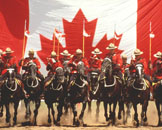 Gordon Gibson had a column in the Vancouver Sun earlier this week, urging that British Columbia should stop re-negotiating its contract for provincial police services with the RCMP – and re-establish the old BC Provincial Police, disbanded back in 1950. (As matters stand, only Ontario and Quebec now have their own police forces. All eight other provinces contract out provincial police services to the federal Mounties.) An article in the same paper the next day reported that “BC Solicitor General John van Dongen said … he’s open to the idea of replacing the RCMP with a provincial police force … he’s currently reviewing all options before making a final decision on whether to renew the RCMP’s provincial contract, which expires in 2012.” According to the Vancouver Sun, all this has something to do with the notion that “Ottawa is not known for running things well.” (Though in Ontario we are also bound to wonder about the federal Bank Act, which has apparently helped give Canada an unusually sound financial system?) In the end, Gordon Gibson’s call for a new approach to provincial policing on Canada’s Pacific Coast is at least equally a reflection of a broader loss of faith in the once iconic Mounties, in all parts of the country. According to a recent opinion poll, “Robert Dziekanski’s death [by taser] at Vancouver’s airport [in October 2007] has eroded public confidence in the RCMP. ” (And, when you dig even just a little deeper, Robert Dziekanski’s death is far from the only case in point!)
Gordon Gibson had a column in the Vancouver Sun earlier this week, urging that British Columbia should stop re-negotiating its contract for provincial police services with the RCMP – and re-establish the old BC Provincial Police, disbanded back in 1950. (As matters stand, only Ontario and Quebec now have their own police forces. All eight other provinces contract out provincial police services to the federal Mounties.) An article in the same paper the next day reported that “BC Solicitor General John van Dongen said … he’s open to the idea of replacing the RCMP with a provincial police force … he’s currently reviewing all options before making a final decision on whether to renew the RCMP’s provincial contract, which expires in 2012.” According to the Vancouver Sun, all this has something to do with the notion that “Ottawa is not known for running things well.” (Though in Ontario we are also bound to wonder about the federal Bank Act, which has apparently helped give Canada an unusually sound financial system?) In the end, Gordon Gibson’s call for a new approach to provincial policing on Canada’s Pacific Coast is at least equally a reflection of a broader loss of faith in the once iconic Mounties, in all parts of the country. According to a recent opinion poll, “Robert Dziekanski’s death [by taser] at Vancouver’s airport [in October 2007] has eroded public confidence in the RCMP. ” (And, when you dig even just a little deeper, Robert Dziekanski’s death is far from the only case in point!)
The Braidwood inquiry, Lorrie Goldstein, and Barbara Yaffe …
 Unsettled feelings about the RCMP across the country have been fanned by BC’s current Braidwood inquiry into Dziekanski’s death, which is at the moment on a two-week break. As Barbara Yaffe of the Vancouver Sun urged this past weekend: “The jarring testimony that has been presented at the Braidwood inquiry suggests it’s time for greater government oversight of the RCMP … The inquiry … isn’t just a test of the four officers whose actions led to the death of Polish immigrant Robert Dziekanski at Vancouver International Airport in October 2007. The reputation of the 136-year-old national police force hangs in the balance.”
Unsettled feelings about the RCMP across the country have been fanned by BC’s current Braidwood inquiry into Dziekanski’s death, which is at the moment on a two-week break. As Barbara Yaffe of the Vancouver Sun urged this past weekend: “The jarring testimony that has been presented at the Braidwood inquiry suggests it’s time for greater government oversight of the RCMP … The inquiry … isn’t just a test of the four officers whose actions led to the death of Polish immigrant Robert Dziekanski at Vancouver International Airport in October 2007. The reputation of the 136-year-old national police force hangs in the balance.”
Back in Ontario Lorrie Goldstein of the Toronto Sun similarly opined: “With the Braidwood Inquiry into the death of Polish immigrant Robert Dziekanski after he was hit by a stun gun now adjourned until March 23, Canadians are left asking the same questions they’ve had from the start … How could this happen? How, in a first-world country that prides itself on multiculturalism and human rights, could a man who did not speak English, legally landing at Vancouver International Airport on Oct. 13, 2007, expecting simply to be reunited with his mother, end up dead 10 hours later?”
The problem goes much deeper than the Dziekanski case, alas. Ms. Yaffe, e.g., goes on: “It had been hoped the RCMP turned a corner in 2007 when the Harper government named William Elliott as the force’s first civilian commissioner … A turnaround certainly was in order after the Maher Arar debacle and tales of RCMP pension fund abuse. Controversies involving the RCMP in BC alone were enough to cause consternation …
“Former justice Ted Hughes, following a 2001 probe of RCMP actions during a 1997 meeting of Asia-Pacific leaders in Vancouver, criticized unnecessary pepper-spraying of demonstrators, unwarranted arrests, improper removal of protest signs and intrusive strip searches … The spotlight was back on the RCMP in BC in 2005 when Ian Bush, a 22-year-old Houston, BC, mill worker, was shot – in the back of the head … He’d been arrested for having an open beer outside a hockey game and giving a false name. Const. Paul Koester – five months out of RCMP training – never faced charges; he was deemed to have acted in self-defence.”
Still other recent Mountie screw-ups, etc, etc …
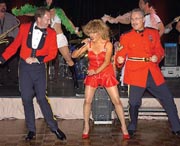 Barbara Yaffe’s allusion to the case of alleged terrorist Maher Arar and the RCMP was seconded this past Tuesday in a Toronto Star article headlined “UN report criticizes Canada for sharing Arar info.”
Barbara Yaffe’s allusion to the case of alleged terrorist Maher Arar and the RCMP was seconded this past Tuesday in a Toronto Star article headlined “UN report criticizes Canada for sharing Arar info.”
For those who may have forgotten: “Arar, a Syrian-born Canadian, was detained at a New York airport in September 2002 and subsequently shipped abroad by US authorities, ending up in a grim Damascus cell where he gave false confessions about terrorist links … In 2007 the [Canadian federal] government apologized to Arar and gave him $10.5 million in compensation … An inquiry led by Justice Dennis O’Connor found the RCMP passed misleading, inaccurate and unfair information to the Americans that very likely led to Arar’s arrest and deportation to face torture in Syria.”
Much more recently – and back in beautiful BC (the most populous province where the Mounties currently provide provincial police services) – there is the case of the RCMP officer who “has apologized to the widower of a skier who died while stranded in the BC back country after the force failed to launch a search when it learned of an SOS message in the snow.”
Then we have another recent case in BC, from the same Yellowhead Highway region where Ian Bush was shot in the back of the head, after he was arrested for having an open beer outside a hockey game and giving a false name, in 2005. The more recent case involves aboriginal peoples: “Gitxsan demand investigation of RCMP … A routine traffic stop of a Gitxsan Hereditary Chief has led to renewed calls for independent investigations of RCMP … The Gitxsan Treaty Office (GTO) said they have grave concerns after one of their hereditary chiefs sustained what they call extensive head injuries during a struggle with a New Hazelton RCMP member.”
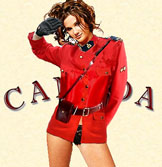 Meanwhile, over in Saskatchewan a troubling trial is underway: “Mountie murder verdict hinges on self-defence … A jury must decide whether a man shot and killed two Saskatchewan Mounties in self-defence or whether his version of what happened is an illogical attempt at avoiding prison.”
Meanwhile, over in Saskatchewan a troubling trial is underway: “Mountie murder verdict hinges on self-defence … A jury must decide whether a man shot and killed two Saskatchewan Mounties in self-defence or whether his version of what happened is an illogical attempt at avoiding prison.”
The account goes on: Saskatchewan “Crown prosecutor Al Johnston said in his closing arguments … that Curt Dagenais cannot be believed. His story is a fantasy designed to help him get away with murder,’ Johnston told the jury … Defence lawyer Bill Roe said Dagenais reacted only after he had been shot at and because he feared for his life. Self-defence is the issue. Who shot first?’ said Roe … Dagenais testified that constables Marc Bourdages and Robin Cameron fired at him first without warning and he fired back blindly to save his own life … his panic and fear fed by flashbacks of an alleged previous beating by the RCMP.”
Then of course there is the extremely unusual and unsettling role played by the RCMP in the 2006 Canadian federal election campaign. Last April the Toronto Star noted: “A report this week has finally shed some light on the RCMP’s unprecedented intervention in the last federal election campaign, but it still leaves some key questions about this troubling episode unanswered.” As best as we have ever been able to make out, the questions remained unanswered to this day.
And then back in December 2006 Aaron Unruh of The Politic blog was discussing “Replacing the RCMP in Alberta.” In March 2006 Angelo Persichilli was writing in The Hill Times from Ottawa about how “RCMP’s credibility also on the line in Mexico slayings of Canadian couple.” Thanks to the endless present-day resources of the world wide web, we could go on and on … and on and on and on. But even this brief and highly casual survey makes the essential point clear enough. As The Daily Gleaner in New Brunswick summarized the story yesterday: “Canadians have lost faith in RCMP: poll.”
The iconic history of the Mounties in Canada … a very brief sketch …
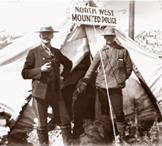 In a similar spirit, this past Tuesday the BC-based Gary Mason at the Globe and Mail published a column headlined: “If they are ever to restore a once-proud reputation, the Mounties must first become accountable.”
In a similar spirit, this past Tuesday the BC-based Gary Mason at the Globe and Mail published a column headlined: “If they are ever to restore a once-proud reputation, the Mounties must first become accountable.”
Mr. Mason understandably quite correctly felt a need to stress: “Every time I write about this subject, I feel compelled to include this paragraph: RCMP officers have a tough and dangerous job. The majority are good men and women who work hard to protect our safety.” Then he went on: “That said, a string of incidents in BC (and elsewhere) over the past few years has seemingly exposed a protect-the-officer-at-all-costs culture.”
Before rushing to too many hasty judgments about all this, it probably makes some sense to very briefly consider the 136-year history that lies somewhere at the bottom of the Mounties “once-proud reputation” – and iconic status as the one thing about Canada many people outside Canada are actually dimly aware of (or at least used to be).
Taking the official RCMP website today as the key source, there have been three broad eras in the history of the Mounties, each of which involves a somewhat different name: the founding era of the Northwest Mounted Police (NWMP), 18731904; the transitional era of the Royal Northwest Mounted Police (RNWMP), 19041920; and the current era of the Royal Canadian Mounted Police (RCMP), 1920present.
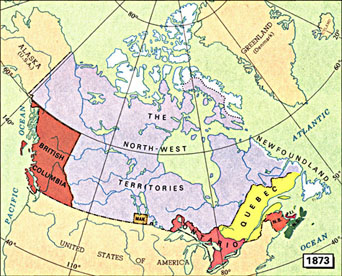 In 1873 the federal Parliament at Ottawa “passed an act to provide for the establishment of a Mounted Police Force for the Northwest Territories‘.” (At that point the Northwest Territories included most of what are now northern Ontario and northern Quebec, the three Prairie Provinces, and the three northern territories of Canada today.) The “NWMP’s main task between 1874-85 was to establish and maintain amicable relations with the native peoples of the Northwest Territories.”
In 1873 the federal Parliament at Ottawa “passed an act to provide for the establishment of a Mounted Police Force for the Northwest Territories‘.” (At that point the Northwest Territories included most of what are now northern Ontario and northern Quebec, the three Prairie Provinces, and the three northern territories of Canada today.) The “NWMP’s main task between 1874-85 was to establish and maintain amicable relations with the native peoples of the Northwest Territories.”
In the midst of this important work the NWMP also helped put down the Northwest or Second Riel Rebellion of 1885. Along with the Canadian Pacific Railway (also completed in 1885), this helped open up Western Canada to new settlement. Partly because of the Mounties (although perhaps mostly because of the long history of the “Indian-European” fur trade in Canada), the modern mass settlement of the “last best west” in the most northern parts of North America was more orderly and less wild than in the great republic to the south. As the official website puts it, by the early 20th century “the Mounted Police had achieved an international reputation for their role in Western Canada’s orderly development.” (The Mounties “always get their man,” etc, etc.)
In their distinctive red tunics and many other features, the Northwest Mounted Police in Canada were a creation of the culture of the global British empire of the late 19th and early 20th centuries, as well as an indigenous institution of the Canadian confederation that began in 1867. (According to the act of the Canadian Parliament that established the NWMP members of the force were required to “be able to read and write either the English or French language.”)
As explained on the official website today: “In 1897, a NWMP detachment represented Canada at Queen Victoria’s Diamond Jubilee in London. Further contingents participated in King Edward VII and King George V’s coronations in 1902 and 1911, respectively. During the South African War, members of the Force had been given leave of absence to fight with the 2nd Battalion, Canadian Mounted Rifles and the Lord Strathcona’s Horse. In 1904, their achievements received recognition when King Edward VII granted the Force the prefix Royal’ and it became the Royal Northwest Mounted Police (RNWMP).”
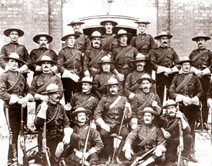 The First World War (19141918) marked an important turning point for both Canada and the RNWMP. As explained on the official website, once again: “In February 1920, the Mounted Police absorbed the Dominion Police, which had carried out federal policing in eastern Canada. Headquarters was moved from Regina to Ottawa and the Force became responsible for enforcement of federal laws from the Atlantic to the Pacific. In keeping with its new role, it was renamed the Royal Canadian Mounted Police.”
The First World War (19141918) marked an important turning point for both Canada and the RNWMP. As explained on the official website, once again: “In February 1920, the Mounted Police absorbed the Dominion Police, which had carried out federal policing in eastern Canada. Headquarters was moved from Regina to Ottawa and the Force became responsible for enforcement of federal laws from the Atlantic to the Pacific. In keeping with its new role, it was renamed the Royal Canadian Mounted Police.”
Meanwhile, when Alberta and Saskatchewan became provinces in 1905 the role of the old NWMP in enforcing both federal and regional or provincial laws in these places was carried on by the RNWMP. Then new provincial police forces took over for a time – in Alberta, e.g., from 1917 to 1932. Then the RCMP returned “to provincial policing in 1928 under contract to Saskatchewan.” And “provincial policing responsibilities” were similarly assumed by the RCMP “in Manitoba, New Brunswick, Nova Scotia and Prince Edward Island” (as well as Alberta) in1932 . Finally, “provincial policing contracts” were “extended to include British Columbia and Newfoundland in 1950” – to arrive at the present arrangements, under which “Provinces and territories in Canada (except Ontario and Quebec) have contracts with the federal government for policing services, which are delivered by the RCMP.” (Though some would want to stress that the Royal Newfoundland Constabulary still looks after provincial policing in St. John’s and a few other areas of the province, apparently “accounting for about 40 per cent of the province’s population” – not altogether unlike distinctive urban regional police forces in Montreal, Toronto, Vancouver, and other such places.)
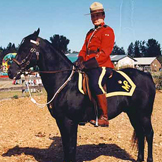 Two further items round out this very quick look at the Mountie past. The first is a perhaps unduly long set of haphazard quotations from a Wikipedia report on a radio and then television series of a somewhat earlier era: “Challenge of the Yukon was a long-running radio series that began on Detroit’s station WXYZ … The series was first heard on February 3, 1938. Under the title Sergeant Preston of the Yukon, it later transferred to television … The program was an adventure series about Sergeant William Preston of the Northwest Mounted Police and his lead sled dog, Yukon King, as they fought evildoers in the Northern wilderness during the Gold Rush of the 1890s … Preston worked under the command of Inspector Conrad, and in the early years was often assisted by a French-Canadian guide named Pierre … Challenge of the Yukon began as a 15-minute serial, airing locally from 1938 until May 28, 1947. Shortly thereafter, the program acquired a sponsor, Quaker Oats, and the series, in a half-hour format, moved to the networks. The program aired on ABC from June 12, 1947 to December 30, 1949. It was then heard on The Mutual Broadcasting System from January 2, 1950 through the final broadcast on June 9, 1955. The title changed from Challenge of the Yukon to Sergeant Preston of the Yukon in November 1951, and remained under that name through the end of the series and into television … From 1951 to 1958 Dell Comics published 29 issues of Sergeant Preston of the Yukon … In 1955, the same year the radio show ended, Sergeant Preston of the Yukon premiered as a television series … Mainly filmed at Ashcroft, Colorado, the series was telecast on CBS from September 29, 1955, to September 25, 1958. … The series was parodied many times over the years. Radio comics Bob and Ray came up with King Yukon of the Northwest, a rabid dog who viciously attacked the [M]ountie[s] and all around him.”
Two further items round out this very quick look at the Mountie past. The first is a perhaps unduly long set of haphazard quotations from a Wikipedia report on a radio and then television series of a somewhat earlier era: “Challenge of the Yukon was a long-running radio series that began on Detroit’s station WXYZ … The series was first heard on February 3, 1938. Under the title Sergeant Preston of the Yukon, it later transferred to television … The program was an adventure series about Sergeant William Preston of the Northwest Mounted Police and his lead sled dog, Yukon King, as they fought evildoers in the Northern wilderness during the Gold Rush of the 1890s … Preston worked under the command of Inspector Conrad, and in the early years was often assisted by a French-Canadian guide named Pierre … Challenge of the Yukon began as a 15-minute serial, airing locally from 1938 until May 28, 1947. Shortly thereafter, the program acquired a sponsor, Quaker Oats, and the series, in a half-hour format, moved to the networks. The program aired on ABC from June 12, 1947 to December 30, 1949. It was then heard on The Mutual Broadcasting System from January 2, 1950 through the final broadcast on June 9, 1955. The title changed from Challenge of the Yukon to Sergeant Preston of the Yukon in November 1951, and remained under that name through the end of the series and into television … From 1951 to 1958 Dell Comics published 29 issues of Sergeant Preston of the Yukon … In 1955, the same year the radio show ended, Sergeant Preston of the Yukon premiered as a television series … Mainly filmed at Ashcroft, Colorado, the series was telecast on CBS from September 29, 1955, to September 25, 1958. … The series was parodied many times over the years. Radio comics Bob and Ray came up with King Yukon of the Northwest, a rabid dog who viciously attacked the [M]ountie[s] and all around him.”
There are two ingredients to the second item. First, women were recruited as RCMP officers for the first time in 1974. And second, whether they are women or men,. RCMP officers today do not wear their classic scarlet or red serge tunics when they are on ordinary duty. This has become a strictly dress uniform.
What is to be done?
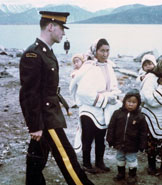 Who knows? British Columbia and Alberta may soon enough join Ontario and Quebec as large provinces with their own police forces, while only the six smaller provinces will continue to contract out provincial policing services to the federal RCMP. And this might help jolt the Mounties of today into the 21st century.
Who knows? British Columbia and Alberta may soon enough join Ontario and Quebec as large provinces with their own police forces, while only the six smaller provinces will continue to contract out provincial policing services to the federal RCMP. And this might help jolt the Mounties of today into the 21st century.
Some better accountability structure for the force in Ottawa may also be in the wind – as various journalists have recently urged.
But the ultimate bottom line here may just be that the RCMP never will regain the iconic status and respect that it used to have in the Canada of an earlier day. And thinking of Bob and Ray’s King Yukon of the Northwest that may not be so terrible.
For one thing, the Mounties are as much an artifact of Canada’s colonial past as the first self-governing dominion of the British empire, as they are of any indigenous, independent, and forward-looking Canadian confederation. We have also been advised (not very seriously, of course) that even when Canadians formally decide to remove their last formal ties to the British monarchy at last, “RCMP” could still remain intact as “Republican Canadian Mounted Police.” But on further reflection that begs the question of why Canada’s federal police service has to be “Mounted” in the present day and age? No doubt, the debate will continue. And hopefully, RCMP officers will at least win back the respect of the larger public that they do deserve.
The counterweights editors would like to thank Larry Olsen, LLB and the Toronto artist Michael J. Seward for their valued consulting services in connection with this article.

